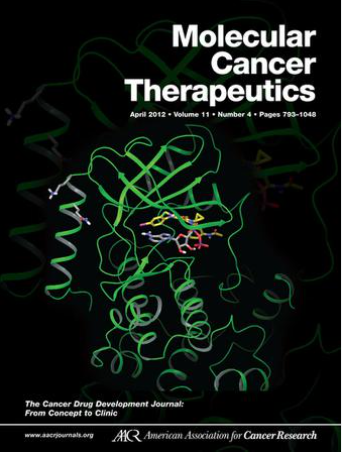摘要 B004:异源CRISPR筛选发现新型MYC驱动的脆弱性
IF 5.3
2区 医学
Q1 ONCOLOGY
引用次数: 0
摘要
c-MYC(MYC)是一种中心调控蛋白,在50%以上的人类癌症中都会出现调控失调,并与侵袭性疾病有关。开发 MYC 抑制剂将彻底改变癌症治疗方法;然而,开发直接靶向 MYC 的小分子药物具有挑战性。另一种方法是识别并抑制关键的 MYC 伙伴蛋白,使 MYC 失活并引发癌细胞死亡。治疗性抑制这些靶点可导致合成致死(MYC-SL),MYC-SL 可用于 MYC 失调的癌症。为了鉴定 MYC-SL 靶点,我们使用一对正常和 MYC 驱动的乳腺癌细胞进行了全基因组 CRISPR 基因敲除筛选。与其他筛选不同的是,该模型依赖于 MYC,并在体内病理和分子水平上再现了人类疾病。我们通过两种独立的方法从筛选中确定了需要验证的高优先级基因:1) 传统的基因组富集分析,以确定高代表性的生物通路;以及 2) 分析癌症依赖性图谱 (DEPMAP),以选择在筛选条件之外可能具有稳健性的基因组。利用传统的基因组富集分析方法,我们发现拓扑异构酶 1(TOP1)是一个可操作的漏洞,可以用临床批准的抑制剂作为靶点。与对照细胞相比,基因和药物抑制 TOP1 会导致 MYC 驱动的细胞死亡。最后,对 TOP1 抑制剂的药物反应与乳腺癌细胞系和患者衍生的器官组织中的 MYC 水平和活性密切相关,这表明 TOP1 是治疗 MYC 驱动型癌症的理想靶点。作为解读 CRISPR 筛选结果的第二种方法,我们分析了 DEPMAP,以确定在 MYC 依赖性癌细胞中不同程度地必不可少的 MYC-SL。具体来说,数百种癌细胞系的 RNA 干扰筛选数据被用来描述这些细胞对 MYC 敲除的反应。这些数据被用来在分析中定义依赖 MYC 的细胞系和不依赖 MYC 的细胞系。然后研究了这两组细胞系对我们的 MYC-SL 基因敲除的反应。在 DEPMAP 的 MYC 依赖性癌细胞中,MYC-SL 也有不同程度的必需性,因此我们优先对其进行了进一步研究。我们和其他人已经验证的关键 MYC 辅助因子(如 CDK9)也被确定下来,从而为这种方法提供了信心,并使正在进行的研究更加合理。总之,这项工作采用了两种成功的策略,从数百个合成致死基因组范围的 CRISPR 筛选中优先选择命中的基因,以鉴定癌症中新的 MYC 驱动的脆弱性。引用格式:Peter Lin, Linda Penn.异源 CRISPR 筛选发现新型 MYC 驱动的脆弱性 [摘要].In:AACR 癌症研究特别会议论文集:扩展和转化癌症合成漏洞;2024 年 6 月 10-13 日;加拿大魁北克省蒙特利尔。费城(宾夕法尼亚州):AACR; Mol Cancer Ther 2024;23(6 Suppl):Abstract nr B004.本文章由计算机程序翻译,如有差异,请以英文原文为准。
Abstract B004: An isogenic CRISPR screen identifies novel MYC-driven vulnerabilities
c-MYC (MYC) is a central regulatory protein that is dysregulated in >50% of all human cancers and is linked to aggressive disease. Developing MYC inhibitors would revolutionize cancer treatment; however, developing small molecules that directly target MYC is challenging. An alternative approach is to identify and inhibit critical MYC partner proteins to inactivate MYC and trigger cancer cell death. Inhibiting these targets therapeutically can result in synthetic lethality (MYC-SL), which can be exploited in MYC-dysregulated cancers. To identify MYC-SL targets, we performed a genome-wide CRISPR knock-out screen using an isogenic pair of normal and MYC-driven breast cancer cells. In contrast to other screens, this model is dependent on MYC and recapitulates human disease at both pathological and molecular levels in vivo. We identified high-priority hits to validate from the screen using two independent approaches: 1) a traditional gene-set enrichment analysis to identify highly represented biological pathways; and 2) analyzing the Cancer Dependency Map (DEPMAP) to select hits that are likely to be robust beyond the context of our screening conditions. Using a traditional gene-set enrichment analysis approach, we identified topoisomerase 1 (TOP1) as an actionable vulnerability that can be targeted with clinically approved inhibitors. Genetic and pharmacological inhibition of TOP1 resulted in MYC-driven cell death compared to that in control cells. Finally, drug response to TOP1 inhibitors significantly correlated with MYC levels and activity across panels of breast cancer cell lines and patient-derived organoids, highlighting TOP1 as a promising target for MYC-driven cancers. As a secondary approach to interpreting our CRISPR screen hits, we analyzed DEPMAP to identify MYC-SLs that are differentially essential in MYC-dependent cancer cells. Specifically, data from RNA interference screens in hundreds of cancer cell lines were used to describe the response of these cells to MYC knockdown. These data were used to define MYC-dependent and MYC-independent cell lines within the context of this analysis. These two groups were then investigated for their in silico response to the knockdown of each of our MYC-SL hits. MYC-SLs, which were also differentially essential in MYC-dependent cancer cells from DEPMAP, were prioritized for further investigation. Critical MYC cofactors that have been validated by us and others (e.g., CDK9) were identified, providing confidence in this approach, and rationalizing ongoing investigations. Together, this work features two successful strategies to prioritize hits from hundreds of synthetic-lethal genome-wide CRISPR screens to identify novel MYC-driven vulnerabilities in cancer.
Citation Format: Peter Lin, Linda Penn. An isogenic CRISPR screen identifies novel MYC-driven vulnerabilities [abstract]. In: Proceedings of the AACR Special Conference in Cancer Research: Expanding and Translating Cancer Synthetic Vulnerabilities; 2024 Jun 10-13; Montreal, Quebec, Canada. Philadelphia (PA): AACR; Mol Cancer Ther 2024;23(6 Suppl):Abstract nr B004.
求助全文
通过发布文献求助,成功后即可免费获取论文全文。
去求助
来源期刊
CiteScore
11.20
自引率
1.80%
发文量
331
审稿时长
3 months
期刊介绍:
Molecular Cancer Therapeutics will focus on basic research that has implications for cancer therapeutics in the following areas: Experimental Cancer Therapeutics, Identification of Molecular Targets, Targets for Chemoprevention, New Models, Cancer Chemistry and Drug Discovery, Molecular and Cellular Pharmacology, Molecular Classification of Tumors, and Bioinformatics and Computational Molecular Biology. The journal provides a publication forum for these emerging disciplines that is focused specifically on cancer research. Papers are stringently reviewed and only those that report results of novel, timely, and significant research and meet high standards of scientific merit will be accepted for publication.

 求助内容:
求助内容: 应助结果提醒方式:
应助结果提醒方式:


